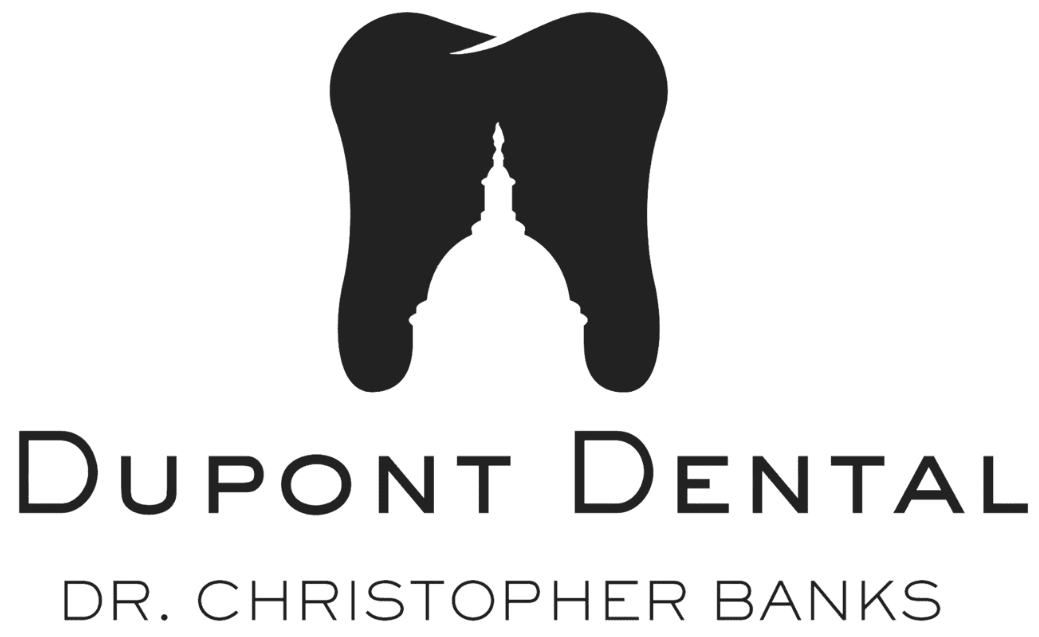Dental bonding uses tooth-colored ceramic or composite resin materials to improve the look of the smile. Patients with damaged or discolored teeth benefit from bonding treatment, receiving more balanced and bright teeth. Tooth bonding can add structure to teeth and change the shape and shade of the enamel. Dr. Christopher Banks provides teeth bonding as a cosmetic dental service in Washington, DC, to improve the appearance of the natural smile.

What Can Dental Bonding Treat?
Similar to porcelain veneers, teeth bonding in our Washington, DC, dental office can treat many different conditions. It just provides treatment more affordably and temporarily. Bonding is one of the most affordable dental procedures, partly because it can be removed.
While it isn’t a permanent procedure like porcelain veneers, it can still last an average of 3 to 7 years if you take care of it properly. Since it’s removable and reversible, we can use bonding to treat children. Dental bonding can address the following:
- Tooth Stains: Everyone deals with tooth discoloration at some point. Deep intrinsic staining doesn’t respond to professional teeth whitening. We can color-match bonding material to match any shade of white you desire.
- Gaps Between Teeth: If you have small gaps between your teeth, we can mold bonding to close those gaps. When gaps are small, bonding can eliminate the need for orthodontics and more expensive procedures. Bonding is also a great option for back triangles, or small gaps between the teeth and gums.
- Tooth Chips or Cracks: We recommend bonding for small chips or cracks in your teeth. Bonding can help add more structure to these teeth and create an even look. They can also potentially prevent small chips from worsening over time.
The Benefits of Dental Bonding
Tooth bonding has many benefits. Since it’s malleable, we can mold the material to match the shape and size of the problem tooth completely. This way, it looks natural and blends in with your smile.
We can create any shape and size you need with the material’s flexibility. If a portion of your tooth chips or breaks off, we can mold bonding material to fill in the missing portion to make your tooth whole again. This provides both cosmetic and restorative benefits.
If a large portion breaks off, it can expose the sensitive nerves and soft tissues inside the tooth. Finishing the tooth again eliminates nerve pain and sensitivity and protects the inside of your tooth from bacteria. Each bonding treatment session is unique.
Tooth Bonding vs. Porcelain Veneers
Veneers and dental bonding both improve the appearance of your teeth, but they work differently. Dental veneers are thin, custom-made shells that are placed over the front of your teeth.
They are usually made of porcelain and can fix problems like discoloration, gaps, and uneven teeth. While they are durable and look natural, they can cost more than options like bonding.
Bonding offers a quicker and more economical option for fixing minor issues like small chips or stains. While bonding is effective, it may not last as long as veneers. However, we can easily remove and repair bonding material. Veneers permanently remove a portion of your tooth enamel, and bonding does not require as much preparation.
Teeth Bonding Treatment in Washington, DC
Dental bonding is a non-invasive treatment that takes just one in-office visit. Before treatment, we will fully examine your teeth and gums. If you have dental issues like tooth decay or gum disease, we will treat those issues first. Like other cosmetic treatments, good oral health will ensure your bonding lasts. We will also clean your teeth for the best results.
To begin bonding treatment, Dr. Banks cleans the tooth and then preps it for the bonding material by gently roughening the tooth surface. The rougher surface helps the dental material adhere to the tooth. Before applying the bonding material, Dr. Banks ensures that it matches the tooth’s color.
After Dr. Banks applies the bonding material to the tooth, it dries. Finally, he buffs and polishes the tooth to blend in with the other natural teeth. Dental bonding treatment is comfortable, painless, and quick. We can complete tooth bonding treatment in just one visit to our office.
Aftercare
Caring for your bonded teeth will help keep them bright and intact. Follow these tips to care for bonding treatment.
Avoid Certain Foods and Drinks
Avoid foods and drinks that typically stain teeth directly after bonding treatment. Coffee, tea, berries, and wine can stain the bonding material. Try to avoid these staining foods and drinks for at least 48 hours after the treatment. This gives the bonding material time to fully set.
You should also avoid hard or crunchy foods. Eating hard foods, like nuts or ice, can put a lot of pressure on the bonding and might cause it to crack or chip. This can make your teeth look uneven or lead to extra trips to the dentist for repairs. Sticking to a soft diet right after treatment will also help you get used to your bonded teeth.
Clean Your Teeth
Cleaning bonded teeth does not require special methods; gently brushing and flossing them will keep them bright. To care for bonded teeth, brush at least twice daily and floss at least once daily. When choosing a toothbrush, ensure that it has soft bristles. Medium and hard bristles are more abrasive and can erode the bonding material when brushing teeth.
You should also use regular dental floss and avoid stick flossers. Toothpastes that use activated charcoal and mouthwashes that contain alcohol also wear down the bonding material.
Avoid Bad Habits
When you eat, try not to bite down on hard foods like pretzels and nuts directly on where the bonding material is. Don’t use your teeth for anything other than their normal purpose.
Opening packages with your teeth can affect not only the bonding material but also your natural tooth structure. Habits like chewing on pens or biting your nails can have the same effect.
Patient Review
Tooth Bonding FAQs
We welcome you to learn more about tooth bonding in Washington, DC, with answers to these commonly asked questions.
Am I a candidate for tooth bonding?
You may be a good candidate for tooth bonding if you have minor cosmetic issues with your teeth, like small chips, cracks, gaps, or discoloration. Tooth bonding works well for people who want to improve the look of their teeth without major dental work.
It’s best for patients who have healthy teeth and gums. If you have cavities or gum disease, your dentist will likely recommend treating those issues first before considering bonding.
Is tooth bonding permanent?
No, bonding is not permanent. Treatment can last 5 to 10 years with the right care. If your tooth bonding does chip or wear down, call us so we can repair or replace the material. We can reapply the resin to fix any issues and keep your smile looking great.
Can you whiten tooth bonding?
You cannot whiten tooth bonding like you can whiten natural teeth. Tooth bonding is made from a special resin material that does not respond to whitening treatments like bleach does. So, if you try whitening on bonded teeth, they won’t change color.
Talk to our dentist first if you’re considering whitening your natural teeth. We can help you determine the best way to match the color of your bonded teeth with your whitened teeth afterward.
How long does dental bonding take?
Dental bonding is a quick procedure that usually takes about 30 to 60 minutes per tooth. It can often be completed in just one visit to the dentist. During the procedure, your dentist will apply a tooth-colored resin to your tooth, shape it, and harden it with a special light. After that, the resin is polished to match the look of your natural teeth.
The whole process is simple and painless, and you can return to your normal activities right after the appointment.
Is tooth bonding painful?
No, tooth bonding is not painful. Most patients don’t need anesthesia because the procedure is simple and doesn’t involve drilling or affecting sensitive parts of the tooth. During bonding, your dentist applies a tooth-colored resin to the surface of your tooth, shapes it, and hardens it with a special light.
Can I reverse bonding treatment?
Yes, bonding treatment can be reversed. The tooth-colored resin used in bonding is applied to the surface of your tooth, so it can be carefully removed by your dentist if needed. However, keep in mind that the process may take time, and removing the bonding material could affect the appearance of your tooth.
If you’re unsure about bonding, it’s best to discuss all your options with your dentist before treatment to make sure it’s the right choice for you.
Can I get tooth bonding for a single tooth?
Yes, you can get tooth bonding for a single tooth. Since bonding is a quick and simple treatment, it works well for fixing a single tooth. We can often complete bonding treatment in just one visit to the dentist.
Is teeth bonding expensive?
Teeth bonding is generally one of the more affordable cosmetic dental treatments. The cost can vary depending on the number of teeth that need to be bonded and the complexity of the procedure.
Bonding is usually less expensive than other cosmetic treatments like veneers or crowns. We can give you a more accurate estimate based on your specific needs. If you have dental insurance, it may cover some or all of the cost, especially if the bonding is being done for a necessary repair rather than just cosmetic reasons.
Enhance Your Smile Today
Are you looking for a quick and effective way to fix a chipped tooth? Ask us about dental bonding treatment. Schedule a dental appointment with Dr. Banks online. You may also call Dupont Dental at (202) 946-4720.
